

Coats of Arms were originally created by individuals to identify themselves in times of war and other conflicts. Eventually Coats of Arms were used more to reflect one's accomplishments and achievements as well as representing their social or professional stature and position. In the heraldic traditions of England and Scotland only an individual, rather than a family, can have a coat of arms. In those traditions coats of arms are legal property and can only be used undifferentiated by one person at any given time. Other descendants of the original bearer could bear the ancestral arms only with some change, usually a different color or the addition of a distinguishing charge.
Organizations, such as our
Jam?son Family Network are however allowed to have a Coat of Arms representing themselves, as such and with the artistry and generosity of world renowned heraldic artist
Andrew Stewart Jamieson, the arms he created as depicted on the left can be used by any and all who are members of that group, as their coat of arms, effectively making those arms as the Jam?son coat of arms for anyone who wants that.
Andrew Jamieson's rendition of our Coat of Arms, is made up in part, from several elements found in old known Jam?son armorial bearings, some dating back as far as the fifteenth century, including the shield's basic layout. Technically speaking our Blazon is; Per saltire Azure and Argent in chief an anchor Or and in base an ancient ship in full sail also Or and for a crest, upon a wreath of the colors an ancient ship in full sail proper it's pennons flying Or with a sail per saltire Azure and Argent in chief an anchor Or and in base an ancient ship also Or, mantled Azure and doubled Argent. Our motto "Multi Diversarum Orisinum" is Latin for "From Many Different Origins."

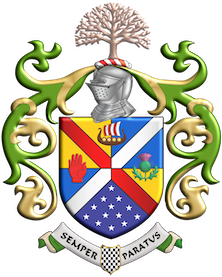

 This is the Arms of John Arthur Jameson: genealogist and Jam?son family historian, who is a descendant and member of this Jameson family. These arms are also used by his direct descendants, although each with different crests.
This is the Arms of John Arthur Jameson: genealogist and Jam?son family historian, who is a descendant and member of this Jameson family. These arms are also used by his direct descendants, although each with different crests.
The arms have a shield design which is both quartered and with saltire, where the yellow area with red saltire and red hand signifies Ulster, Ireland; the blue area with white saltire and thistle, signifies Scotland; the ship signifies a sea arrival by ship, perhaps Scandinavian; and the dark blue quadrant with thirteen white stars; signifies the thirteen early colonies of New England, in America. The crest upon a wreath is a tree in brunàtre, signifying that of family genealogy. Manteling is of green and yellow floral design. With the motto "Semper Paratus" - Latin for "Always Prepared"

Arms depicted below, are those some of those associated with families connected with our various Jameson families. It should be noted that we do not always know if or how they may have been actually associated with a specific ancestor or family, rather, these are only included here as a way of background and amusement. For a more comprehensive list of Coats of Arms belonging to various people of different Jam?son families, go here or here.
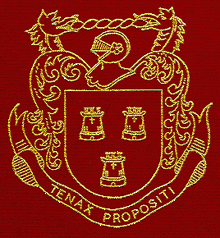

 This is the Coat of Arms of Edward Howell of Southampton, New York, as it appears on the cover of Emma Ross' Howell book. He was born at the Manor of Westbury, Marsh Gibbon, Buckinghamshire, England and baptized 22 July 1584 at Marsh Gibbon, Buckinghamshire. He married (1) Frances Paxton, who died 2 July 1630 and was buried in England, and married (2) Eleanor, who came to Boston with him in 1639. Edward Howell died in 1655 and is buried in Southampton, Long Island, New York.
This is the Coat of Arms of Edward Howell of Southampton, New York, as it appears on the cover of Emma Ross' Howell book. He was born at the Manor of Westbury, Marsh Gibbon, Buckinghamshire, England and baptized 22 July 1584 at Marsh Gibbon, Buckinghamshire. He married (1) Frances Paxton, who died 2 July 1630 and was buried in England, and married (2) Eleanor, who came to Boston with him in 1639. Edward Howell died in 1655 and is buried in Southampton, Long Island, New York.
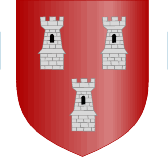 "Gules; Three Towers, tripled towered, Argent" - Motto: "Tenax Propositi" = Firm of purpose.
"Gules; Three Towers, tripled towered, Argent" - Motto: "Tenax Propositi" = Firm of purpose.
DESCENDANTS OF EDWARD HOWELL, by Emma Howell Ross, The University Press, Winchester, MA. (As pictured on the cover)




 This is a Temple Coat of Arms as pictured in the book "The Rise of the Temples." It is first seen on the Tomb of Nicholas Temple of Temple Hall who died in 1506. This crest is described as a favorite, amongst others, with Americans.
This is a Temple Coat of Arms as pictured in the book "The Rise of the Temples." It is first seen on the Tomb of Nicholas Temple of Temple Hall who died in 1506. This crest is described as a favorite, amongst others, with Americans.

 "A silver shield on which there are two black bars with three golden martlets" - Motto: "Templa Quam Dilecta" = How Beautiful are Thy Temples!
"A silver shield on which there are two black bars with three golden martlets" - Motto: "Templa Quam Dilecta" = How Beautiful are Thy Temples!
THE RISE OF THE TEMPLES, by Albert R. Temple and Danny D. Smith. The TEMPLE Family Association


 This is the Hemingway Coat of Arms as embossed on the cover of the book
"The Addendum to Descendants of Isaac Hemingway, Jr." Printed by the Hemingway Book Committee of Ann Arbor, Michigan in 1981
This is the Hemingway Coat of Arms as embossed on the cover of the book
"The Addendum to Descendants of Isaac Hemingway, Jr." Printed by the Hemingway Book Committee of Ann Arbor, Michigan in 1981
 "Black shield with three red stars on a wavy silver fesse between three gold swans" - Crest: A swans head.
"Black shield with three red stars on a wavy silver fesse between three gold swans" - Crest: A swans head.

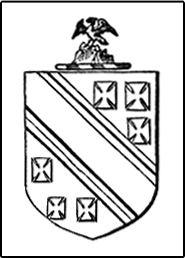

 This is a rendering of a Coat of Arms associated with the Rev. George Bingham (1803), of Melcombe, Dorsetshire, England, as shown on page 350 of "A Genealogical Heraldic History of the Landed Gentry; Volume IV" by Sir John Burke, published in 1838.
This is a rendering of a Coat of Arms associated with the Rev. George Bingham (1803), of Melcombe, Dorsetshire, England, as shown on page 350 of "A Genealogical Heraldic History of the Landed Gentry; Volume IV" by Sir John Burke, published in 1838.
Az. a bend cotized between six crosses patee or. - Crest; a spread eagle rising from a rock, ppr. - Motto "Spes mea Christus" = Christ is My Hope.

 These arms, particularly the shield (unchanged), seems to be used by many other Binghams, including those in Ireland. Specifically the Earls of Lucan and those associated with Bingham Castle in County Mayo. See p.83, "The General Armory of England, Scotland, Ireland and Wales" by Bernard Burke, published in 1884.
These arms, particularly the shield (unchanged), seems to be used by many other Binghams, including those in Ireland. Specifically the Earls of Lucan and those associated with Bingham Castle in County Mayo. See p.83, "The General Armory of England, Scotland, Ireland and Wales" by Bernard Burke, published in 1884.
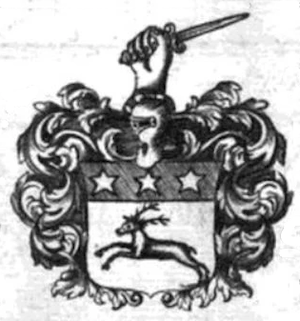

 This is the Doherty Coat of Arms as is often associated with that family in early Donegal, Ulster, Ireland.
An excellent description of this is available on line at the O'Doherty Heritage Website.
This is the Doherty Coat of Arms as is often associated with that family in early Donegal, Ulster, Ireland.
An excellent description of this is available on line at the O'Doherty Heritage Website.
The primary part of the historic arms of the clann Ó Dochartaigh may be described as gules rampant stag in an argent field, vert chief with three stars. This more simply put, means a red jumping horned deer in a white field with three stars in a green bar across the top.
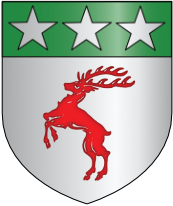
 Of these arms, the O'Doherty Heritage Website says: "There is little information about Irish customs of heraldry before the English arrival, there is evidence that arms belonging to a clan or sept did actually exist (though it's anathema to those holding the English principles of arms). Gaelic chieftainship, under the custom of tanistry, was not inherited by primogeniture (the first son), but was open to the most able man within defined parameters of kinship within the clan and was sometimes embodied in a council (Brittanica; Clans of Ireland). Pat Brennan interprets the evidence by saying, "Most of the arms recorded at this time seem to have been 'sept arms' or 'arms of chieftainship.' In other words, they don't appear to be the private property of a particular individual but belonged to either the sept as a whole or to the chief, possibly as symbol of his office."
Of these arms, the O'Doherty Heritage Website says: "There is little information about Irish customs of heraldry before the English arrival, there is evidence that arms belonging to a clan or sept did actually exist (though it's anathema to those holding the English principles of arms). Gaelic chieftainship, under the custom of tanistry, was not inherited by primogeniture (the first son), but was open to the most able man within defined parameters of kinship within the clan and was sometimes embodied in a council (Brittanica; Clans of Ireland). Pat Brennan interprets the evidence by saying, "Most of the arms recorded at this time seem to have been 'sept arms' or 'arms of chieftainship.' In other words, they don't appear to be the private property of a particular individual but belonged to either the sept as a whole or to the chief, possibly as symbol of his office."
 Family Shields, Crests and Coats of Arms
Family Shields, Crests and Coats of Arms
![]()
![]()

![]()
![]() This is the Arms of John Arthur Jameson: genealogist and Jam?son family historian, who is a descendant and member of this Jameson family. These arms are also used by his direct descendants, although each with different crests.
This is the Arms of John Arthur Jameson: genealogist and Jam?son family historian, who is a descendant and member of this Jameson family. These arms are also used by his direct descendants, although each with different crests.